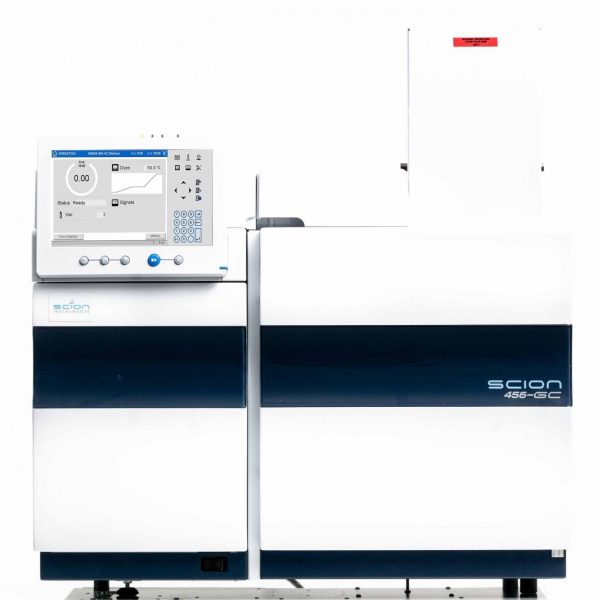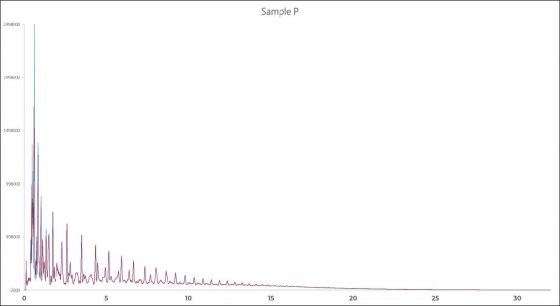ASTM D7169: Boiling Point in Crude Oils & Residual Samples using High Temp SIMDIST
Introduction
In many regions ASTM D7169 may be used for determining the boiling point distribution of Crude Oils and Residual Samples up to a final boiling point of 720°C or lower.
This temperature corresponds to the elution of n-C100, and the method determines the boiling point distribution of these samples from n-C9 up to n-C100 (720°C). This method can also be used for the simulated distillation of other samples that do not fully elute, such as atmospheric and vacuum residues.
The amount of residue (or sample recovery) is determined using an external standard. This provides insight into composition and allows for the determination of intrinsic product value.
While Physical Distillation is still considered the reference method for distillation, and therefore mandatory in many countries for qualifying fuels, Simulated Distillation (SIMDIST) by gas chromatography offers some significant advantages over the physical procedure, making this technique quite useful. Analysis by GC typically has the better precision, higher throughput, less hands-on time and lower cost per sample. Also, SIMDIST requires considerably less sample to be run and can generally be considered the safer of the two techniques.
This method can also be used in tandem with ASTM D7900 (DHA) to complete the characterization of crudes with a significant component in the C1-C9 range. For Crudes with a significant light end this is recommended.
Experimental
The SCION SIMDIST analyser used for this, comprises of a small footprint 436-GC, configured with a temperature programmable cool on column (COC) injector with air cooling, a 5m x 0.53mm x 0.09µm SIMDIST column and a Flame Ionization Detector (FID) with ceramic HT flame tip.
This special flame tip with larger bore ID lowers maintenance frequency, adds sensitivity and improved linearity. The GC oven was equipped with LCO2 coolant to facilitate oven starting at -20°C. A CP-8400 Autosampler was used in Standard On-Column mode. Standards were prepared in CS2 and used to determine system performance. N-paraffin Retention times and response factors were determined. A qualitative mixture of normal paraffins covering the range from C8 up to C100 (1% wt. each in CS2) was used to determine the relationship of boiling point (BP) versus retention times (RT). CS2 blanks were run and evaluated for cleanliness of the blank, for blank subtraction. All samples were dissolved in CS2 (2% m/m) before analysis.
All samples were dissolved in CS2 (2% m/m as per method definition) and injected using the 8400 autosampler onto an air cooled on column injector, while the GC oven was cooled with liquid CO2 down to a temperature of -20°C.
| Injector | Cold-on-Column w. Air cooling |
| Column | SIMDIST 5m x 0.53mm x 0.09µm |
| Oven | Start @ -20°C, 15°C/min to 430°C hold 10 min. |
| Carrier | Helium @ 20ml/min |
| Detector | FID, @ 435°C HT Flame tip |
| Inj. Volume | 0,5µl |
| Software | Compass CDS w/ Eclipse SIMDIST |
Table 1. Analytical conditions
Results
Figure 1 shows a stable baseline and a blank free of any hydrocarbon interferences. Figures 2 and 3 show a chromatogram of the normal paraffins calibration standard and the chromatograms for reference oil 5010.
Reference Oil “5010” was analysed to verify that requirements of ASTM D7169 are met using this configuration. Table 2 clearly shows the analytical results obtained for this reference material passes criteria for acceptance. To demonstrate repeatability of injections, the hydrocarbon response factor was calculated for 2 successive injections of this reference oil (Figure 3). The difference found passes criteria set forth by the method.
| %Off | Consensus Value (°C) | Allowable Difference (°C ) | Result (°C) | CoA Result (°C) |
| IBP | 428 | 9 | 426,3 | 427,4 |
| 10 | 493 | 3 | 492,4 | 493,3 |
| 20 | 510 | 3 | 509,7 | 510,5 |
| 30 | 524 | 4 | 523,3 | 524,5 |
| 40 | 537 | 4 | 535,3 | 537,1 |
| 50 | 548 | 4 | 546,8 | 548,7 |
| 60 | 560 | 4 | 558,4 | 560,4 |
| 70 | 572 | 4 | 570,1 | 572 |
| 80 | 585 | 4 | 583,2 | 585,1 |
| 90 | 602 | 4 | 600,5 | 602,1 |
| FBP | 655 | 18 | 648,7 | 656,3 |
Table 2. Results, reference values and allowable difference for Reference oil 5010 in D7169

Figure 1. D7169 Blank CS2

Figure 2. D7169 Cal. STD (C8-C100)

Figure 3. Reference Oil 5010

Figure 4. Crude P
| % Off | Result A (°C) | Result B (°C) |
| IBP | 46,5 | 45,0 |
| 10 | 99,5 | 99,0 |
| 20 | 129,5 | 129,0 |
| 30 | 157,5 | 157,0 |
| 40 | 188,5 | 188,5 |
| 50 | 223,5 | 224,5 |
| 60 | 263,5 | 264,0 |
| 70 | 309,5 | 308,5 |
| 80 | 371,0 | 368,5 |
| 90 | 455,0 | 449,5 |
| FBP | 650,0 | 648,0 |
| Used Recovery (%) | 100,0 | 100,0 |
Table 3. Crude P % OFF
| BP (°C) | Mass
Recovered A (%) |
Mass
Recovered B (%) |
Allowable
Difference (% m/m ) |
|
| Crude Cut 1 | 82,2 | 4,76 | 4,52 | 1,74 |
|
Crude Cut 2 |
193,3 | 41,15 | 41,16 | 1,92 |
| Crude Cut 3 | 248,9 | 56,37 | 56,22 | 2,05 |
| Crude Cut 4 | 343,3 | 75,75 | 76,05 | 2,28 |
| Crude Cut 5 | 426,7 | 87,08 | 87,60 | 2,58 |
| Crude Cut 6 | 565,6 | 97,50 | 97,69 | 3,03 |
| Crude Cut 7 | 596,1 | 98,48 | 98,58 | 3,12 |
| Crude Cut 8 | 720,0 | NF | NF | 3,17 |
Table 4 Crude P Cut Points

Figure 5. Crude L
| % Off | Result A (°C) | Result B (°C) |
| IBP | 51,5 | 48,5 |
| 10 | 138,5 | 139,5 |
| 20 | 169,0 | 169,5 |
| 30 | 216,0 | 216,0 |
| 40 | 264,0 | 264,0 |
| 50 | 304,5 | 304,5 |
| 60 | 360,0 | 360,0 |
| 70 | 419,0 | 419,5 |
| 80 | 473,0 | 473,5 |
| 90 | 565,5 | 564,0 |
| FBP | NF | NF |
| Used Recovery (%) | 98,9 | 99,3 |
Table 5 Crude L % OFF
| BP (°C) | Mass Recovered A (%) | Mass Recovered B (%) | Allowable
Difference (% m/m ) |
|
| Crude Cut 1 | 82,2 | 2,12 | 2,09 | 1,74 |
| Crude Cut 2 | 193,3 | 24,77 | 24,73 | 1,92 |
| Crude Cut 3 | 248,9 | 36,60 | 36,62 | 2,05 |
| Crude Cut 4 | 343,3 | 57,30 | 57,31 | 2,28 |
| Crude Cut 5 | 426,7 | 71,69 | 71,62 | 2,58 |
| Crude Cut 6 | 565,6 | 90,03 | 90,16 | 3,03 |
| Crude Cut 7 | 596,1 | 92,57 | 92,76 | 3,12 |
| Crude Cut 8 | 720,0 | 99,00 | 99,50 | 3,17 |
Table 6 Crude L Cut Points

Figure 6. Crude W
| % Off | Result A (°C) | Result B (°C) |
| IBP | 79,0 | 77,5 |
| 10 | 162,0 | 160,0 |
| 20 | 239,0 | 234,5 |
| 30 | 313,5 | 307,5 |
| 40 | 394,0 | 390,5 |
| 50 | 454,0 | 451,0 |
| 60 | 527,0 | 523,5 |
| 70 | 613,5 | 608,0 |
| 80 | 703,0 | 694,0 |
| 90 | NF | NF |
| FBP | NF | NF |
| Used Recovery (%) | 81,9 | 83,1 |
Table 7 Crude W % OFF
| BP (°C) | Mass
Recovered A (%) |
Mass
Recovered B (%) |
Allowable
Difference (% m/m ) |
|
| Crude Cut 1 | 82,2 | 0,65 | 0,70 | 1,74 |
| Crude Cut 2 | 193,3 | 14,41 | 15,03 | 1,92 |
| Crude Cut 3 | 248,9 | 20,98 | 21,68 | 2,05 |
| Crude Cut 4 | 343,3 | 34,01 | 34,72 | 2,28 |
| Crude Cut 5 | 426,7 | 44,98 | 45,43 | 2,58 |
| Crude Cut 6 | 565,6 | 64,30 | 64,83 | 3,03 |
| Crude Cut 7 | 596,1 | 596,10 | 596,10 | 3,12 |
| Crude Cut 8 | 720,0 | 82,00 | 83,00 | 3,17 |
Table 8 Crude W Cut Points
Beyond the standards required by the method to show system performance is acceptable, a few real-world crude oils were analysed using this configuration. Figure 4, 5 & 6 show the chromatograms obtained for these samples, while tables 3 through 7 show the respective results. Samples were weighed/diluted in duplicate to demonstrate proper repeatability. Clearly all duplicates pass the allowable difference values for each %BP off.
All three of these crudes are high-value crudes, with a significant light-end component. This is clearly seen in the chromatograms & results, with>20% light ends found for sample “P”.
As per D7169 appendix, this type of very light crude may also be analysed using an additional Front-End DHA method. This is expected to further improve precision & accuracy for the higher value segment of the sample (<150ºC).
Sample “L” and “W” have a broad carbon range, and do not completely elute from the column. Recoveries for these are below 100%, which means no FBP can be determined.
Not with standing the particularities of each of these samples, data demonstrates robustness, precision and compliance abilities of this SCION Instruments ASTM D7169 analyser.
Conclusion
Simulated distillation can provide a very suitable alternative for conventional distillation methods. They typically provide a much more robust, economical, safe automatable, and easy solution for obtaining accurate boiling point and cut point data for petroleum products, feed stocks and other petroleum fractions as specified in these different methods.
In this study, SCION Instruments SIMDIST analyser for D7169 were demonstrated to pass all criteria set forth in the referenced methods with relative ease, providing a compliant solution platform for Simulated Distillation.
Download Application Note
Download the complete Application Note: Boiling Point in Crude Oils & Residual Samples using High Temp SIMDIST (ASTM D7169)
Keep in Touch
A SCION GC Analyser was used to conduct this research. Providing excellent solutions for Environmental, Oil and Gas and Chemical industries, find out more about Scion GC Analysers.
If you would like to speak to a member of our team for more information, please don’t hesitate to get in touch. Or if you wish to keep up to date with SCION Instruments latest research and articles, why not join us on social media and sign up to our newsletters today?
